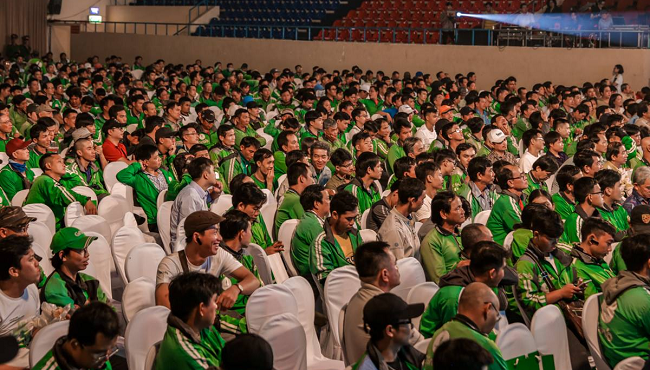Samsung Vietnam appoints its first Vietnamese senior executive
Samsung Vietnam appoints Nguyen Hoang Giang to SEVT senior leadership, the first Vietnamese executive in the company’s local manufacturing units.




Apart from being under the financial pressure of unprofitable business in Vietnam, Grab is also facing fierce competition from the domestic emerging ride-hailing apps such as Go-Viet, Fastgo.
Having been present in Vietnam since 2014, Grab is one of the first ride-hailing applications in the Vietnamese market along with Uber.
By continuously launching promotions, discounts on every single ride, Grab quickly attracted large numbers of users and drivers.
Under the pressure of Uber and Grab, traditional taxi companies have been struggling. Vinasun Taxi has continuously reported losses in passenger transportation services, and only gained profits by selling old cars. Meanwhile, Mai Linh cut more than 3,000 employees in 2017.
Even, Uber, the biggest rival of Grab in the field of ride-hailing in Vietnam, was also acquired by Grab in April 2018, making Grab become a "boss" in Vietnam’s ride-hailing market.
At a recent event, Grab co-founder Tan Hooi Ling said the company currently has 175,000 partners in Vietnam. About every two out of ten Vietnamese people use Grab services. The company's target is to increase this rate to 50 per cent by 2020.
But Grab's business results in Vietnam are disappointing. According to a source, Grab Co., Ltd., operator of Grab Vietnam, had accumulated losses of more than VND1.7 trillion ($73 million) by the end of last year.
Earlier, according to the Ministry of Finance, in the first three years of operations in Vietnam, Grab suffered losses of VND938 billion ($40.2 million).
The main reason for losses is the high selling costs. In 2017 alone, the company spent nearly VND600 billion ($25.7 million) on selling costs, four times higher than in previous years. This reflects that Grab has spent a lot on promotions and marketing to attract partners and customers.
The rapid expansion also caused the company's management costs to rise sharply last year to more than VND200 billion ($8.58 million), three times higher than in 2015.
Operating costs are high while revenue is not enough to offset, causing Grab to borrow loans to maintain its operations. By the end of 2017, the company’s short-term debt reached over VND1.5 trillion ($64.3 million). Previously, Grab Vietnam had borrowed $50 million from its holding company headquartered in Malaysia.

Financial pressures are not the biggest problem for Grab. In Vietnam, many ride-hailing applications, which have recently been launched, have fuelled the competition with Grab. Go-Viet, which is backed by Indonesia-based Go-Jek, is the most outstanding name among Grab’s rivals.
Domestic rail hailing apps such as FastGo under Nexttech Group, or Zalo under VNG also show their ambitions to fight for market share with Grab.
Under the pressure of competition, Grab Vietnam has been continuously launching promotions to maintain its market share. For example, Grab has offered a promotional program in which it charges only VND5,000 ($0.21) for rides less than eight kilometers.
In order to deal with other app-based ride-hailing firms’ appeal to its drivers, Grab has set out regulations that drivers are not allowed to install similar ride-hailing apps, otherwise, they will have bonus cut.
Some Grab drivers said that the number of their rides per day has reduced in recent months, decreasing their income. This results from the increasing numbers of drivers.Grab Vietnam has proposed Ministry of Transport expanding its services in the provinces of Ninh Thuan, Dong Thap, Gia Lai ... However, the ministry has rejected the proposal and requested Grab to deploy services in accordance with pilot project in five province and cities including Hanoi, Ho Chi Minh City, Khanh Hoa, Da Nang and Quang Ninh.Samsung Vietnam appoints Nguyen Hoang Giang to SEVT senior leadership, the first Vietnamese executive in the company’s local manufacturing units.
Michelin is undergoing a strong transformation by applying AI and smart analytic, helping lead the smart, safe, and sustainable mobility revolution in the Industry 4.0 era.
LG Innotek Vietnam Hai Phong secured a $200 million IFC loan as revenue slows, aiming to expand camera module production while meeting sustainability targets.
For Koen Soenens, Sales and Marketing Director at DEEP C, empathy is a compass that guides major deals, the way a leader builds a team, and the ambition to create a sustainable industrial zone that carries a Vietnamese identity.
Taseco Land has shifted its listing to HOSE and introduced a new upward-pointing arrow logo - a visual statement of its strategy to raise capital, expand its land bank, and strengthen its standing in Vietnam’s real estate sector
Located in the heart of Ho Chi Minh City, SAP Labs Vietnam is the second SAP Labs Network hub in Southeast Asia, following Singapore and is one of 20 countries that have SAP Labs globally.